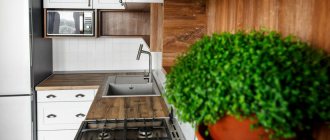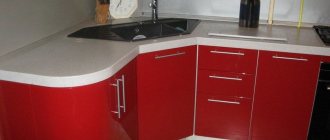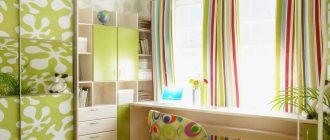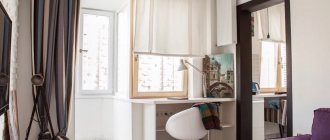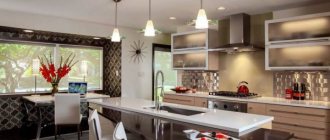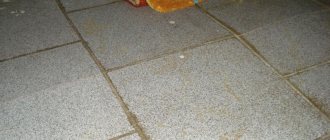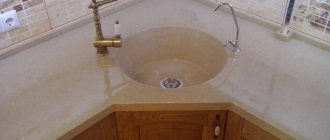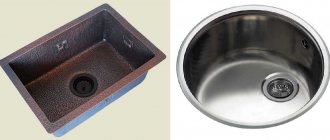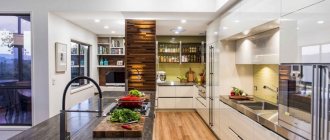Types of kitchen countertops
5 (100%) ratings: 2
The kitchen room is a place that is considered the heart of the home. When arranging it, you need to take into account the combination of all elements: furniture, room design, decorative elements. In this article, we decided to talk about the types of kitchen countertops , what properties they have and how to select the best of the materials offered.
What is she like? This is the upper part of the lower cabinets, which is created from different materials that have certain properties and characteristics.
Requirements for kitchen countertops
The kitchen area is constantly exposed to daily temperature changes, high levels of surface contamination and other influences. All types of kitchen countertops are no exception. Therefore, we decided to give advice on choosing this product.
The product must match the interior of the kitchen, have good practicality, long service life and an affordable price.
Criterias of choice:
Forms
The product is manufactured in two forms:
- cut;
- Solid.
In the case of a cut shape, the individual elements are connected to each other using special elements. When continuous, the surface is uniform, completely sealed.
Dimensions
Products have different size standards. Each material has its own value, which we will introduce you to a little later.
“Housewives are advised to purchase types of kitchen countertops that are wider than the cabinets themselves.”
Colors
There are no specific tips for choosing colors. The main thing is that it is appropriate and NOT superfluous. The correct selection of colors for kitchen countertops will add zest to the interior and create a unique design.
“In order not to make a mistake with the colors, attach samples of the facades to the product.”
There may be many suitable options, so be guided by your taste and do not listen to other people’s opinions. The ideal option is products made from universal shades .
Kitchen countertop colors
For a white kitchen set, stone (cold) or wood material (light) is ideal. It is better to dilute a beige set with dark chocolate or solid chocolate. Both types are complemented by products that do not differ in color from the surface of the facades, but then you need to highlight the wall panel.
Dark types of kitchen countertops always look luxurious, especially in combination with a light interior. In the photo you will see for yourself how unusual the interior immediately becomes.
“Focus on only one of three options: the color of the set, the kitchen countertop, the wall panel.”
Wood, stone, cream and white colors are perfect for wooden facades.
If the kitchen set is two-color, choose types of kitchen countertops with colors for the upper part of the set, but also in parallel with the bottom.
Types and Materials
- MDF;
- chipboard;
- Wood;
- Types of kitchen countertops made of artificial stone;
- A natural stone;
- Glass;
- Metal;
- Types of kitchen countertops made of ceramic tiles.
Plastic
These countertops are made from durable, moisture-resistant chipboard with emission class E1. A sheet of wood-laminated plastic HPL 1 mm thick is applied to the working surface. Under pressure from the press and under the influence of high temperatures, the two components are glued together.
Two edge processing options
According to the method of processing the end, plastic tabletops are available with postforming and with a straight edge:
- By postforming we mean a roll along the front edge of the tabletop with a slight rounding. Under the blockage on the bottom side of the product there is a drip tray - a small recess treated with polyurethane glue. The drip tray protects the chipboard inside the tabletop from moisture. This is one of the main advantages of postformed countertops. The underside of the table top is covered with white laminate or kraft paper, a highly durable kraft pulp material.
- The countertop without a ridge has a rectangular joint between the top layer of plastic and the edge material. The right angle looks modern and relevant. An interesting design solution is to edge a plain tabletop with an edge of a different, contrasting color. Sometimes a 3D edge is used.
If the edge is not carefully applied to the end of the product, moisture can get inside and lead to deformation of the chipboard. Reliable manufacturers use laser edge processing, which guarantees the tightness of the seams.
Peculiarities
The strength of plastic depends on the category of material chosen. Typically it can withstand heat loads up to 100°C. A boiling kettle placed on the surface will not damage the coating. But a cast iron skillet or baking sheet taken out of the oven will damage the plastic. Then you will need to completely replace the countertop with a new one.
The connection of two pieces of countertops for a corner or straight long kitchen occurs both using a Euro saw and a straight seam treated with sealant.
Aluminum strips, an option for joining two rods, have recently been the most popular way to join two countertops. Now they are becoming a thing of the past.
Plastic is easy to use and easy to care for. The use of cleaning gels and products for treating smooth surfaces makes it easy to deal with dirt.
Plastic countertops are also divided into matte and glossy. On glossy ones it is easy to wipe off oil stains, insidious wine or berry blots. It’s more difficult with matte finishes. But on the other hand, drops of water or fingerprints are not visible on matte countertops. Much depends on the pattern and color scheme. The gray textured pattern will hide minor damage and dirt. On a plain surface, stains and minor damage will be more noticeable.
Advantages of plastic countertops:
- huge selection of colors;
- variety in thickness and depth;
- ease of care;
- long service life subject to operating conditions;
- low cost.
- The downside is the inability to restore products after damage.
New group of plastics
The category of plastic countertops also includes new modern materials that are used as facades for kitchen cabinets. They are so durable and moisture-resistant that they have already begun to be used as work surfaces.
A special place among the latest materials for kitchen furniture is occupied by the Cliff stove. It was developed by Italian scientists using a multilayer method of applying a texture coating to an MDF board. The coating is airtight, highly moisture resistant and durable.
New generation plastic Fenix. also called nanoplastic. It is very difficult to damage such material. If you do scratch it, then when treated with a warm iron, the scratch disappears before your eyes.
The downside is the thickness of Cliff and Fenix, which is only 18mm in contrast to the standard tabletop thickness of 28 or 40mm. This does not bother modern designers. After all, kitchens with height differences in countertops are in fashion today.
MDF Kitchen Worktops
Everyone understands that this type of product is constantly exposed to chemical and mechanical stress, so you need to choose a product that is not afraid of scratches, chips, and does not change its shape.
If your budget is limited, and the set itself is made of MDF, then you can also choose MDF for the countertop. It is a particle board made from wood shavings.
Advantages
- Does not emit environmentally harmful substances;
- The price is available for every buyer;
- Service life - about five years;
- Care is very simple and does not require much effort;
Flaws
- Poor moisture resistance (therefore, after some time the product swells);
- Low heat resistance;
- Does not withstand strong mechanical shocks;
- Over time it fades and loses color.
The dimensions established by the GOST standard are 3059 mm length, 600 mm width, 38 mm thickness.
Solid wood worktops
What are they?
Beautiful and durable wooden countertops are made from:
- nut;
- cherries;
- ash;
- oak
Each rock differs from others in internal texture, porosity, color combination, specific gravity and strength characteristics. At the same time, the material creates an atmosphere of special calm and warmth in the kitchen.
To increase its service life, it is impregnated with antiseptic, fire-fighting and water-repellent compounds. To preserve and even enhance the impression of the annual line pattern, transparent or translucent protective solutions are usually used, including oils, paraffins, natural or artificial varnishes.
Solid wood table top.
Strength
Wood requires careful handling, since it is less durable than stone. It can be easily machined, but is also more prone to dents or scratches.
Maintainability
During its entire service life, the wood can be subjected to restorative repairs, followed by sanding and application of decorative and protective compounds.
Stain resistance
Protecting the surface of natural wood from the appearance of stains left by coloring liquids directly depends on the chosen processing technology and the quality of its application.
Heat resistance
Wood itself is a good thermal insulator, but if very hot kitchen accessories come into contact with it, the protective layers can be damaged.
Resistant to fading
The surface of the wood is prone to gradual darkening.
In some cases this is to her advantage:
- the visual relief of the pattern increases;
- adds the charm inherent in old things.
Environmental friendliness
Well-processed wooden products are completely harmless in sanitary, hygienic and environmental terms. The only concern may be the flammability of the material, which requires compliance with basic fire safety rules.
Care
When cleaning wooden surfaces, avoid using abrasive cleaners and detergents.
Appearance and joints
When making countertops, they usually use a solid longitudinal cut of wood 40-50 mm thick or a similar piece made of carefully fitted laminated veneer lumber. In these cases, the joints with adjacent elements of the headset remain clearly visible.
Solid wood countertop design
Price
The price of countertops made from local wood species is always within an acceptable range for the buyer, but increases sharply when using exotic material imported from tropical countries.
Installation features
Even perfectly prepared wood is prone to linear expansion with fluctuations in the temperature and humidity of the air around it. To avoid additional loads associated with this, wooden tabletops are attached to rigid bases only using “floating” technology.
Types of kitchen countertops made of chipboard
Chipboard is a product made from chipboard that can be covered with a laminate (chipboard).
To use it in a kitchen, you need to choose material of class HPL (thickness from 40 mm), E1 and E0 (moisture resistant). Be sure to look at the edge, it must be intact and have rounded edges (postforming), which protects the product from moisture and abrasion.
This is a budget option that is easy to install and repair. A wide selection of colors and sizes, among which you will definitely find one that matches the color of your interior.
"Note! During production, resins are used that will release harmful substances to people.”
All types of chipboard countertops have low heat resistance (180-230 degrees) and resistance to dyes and aggressive liquids. It swells from moisture, especially around the seams and slabs.
A product made from chipboard is a good budget option that will last 4-5 years with proper care.
Chipboard: production, characteristics and advantages
Chipboard is a material made from natural raw materials, shavings and sawdust, which are impregnated with resins. The most important factor in the popularity of the material was its low cost, availability and versatility - it is used in the manufacture of furniture, partitions and other interior elements.
The choice of material for a kitchen countertop is often opted for chipboard, precisely due to the combination of a budget price and decent technical features. It is worth paying attention to an important characteristic of particle boards: formaldehyde resins are used as a binding material. Formaldehyde is known for releasing toxic components, but chipboard manufacturers have taken care of this - only class “E1” boards are used for furniture, boards that are safe for humans. Strict standards for the production of chipboards have been developed that relate specifically to this characteristic of the boards - at the moment, all domestic companies follow strict standards.
A comparison of countertop materials allows us to highlight the following features and advantages of chipboard:
- The use of special impregnation makes it possible to ensure a sufficiently high level of surface resistance to moisture - this is achieved by using a paraffin emulsion.
- Used for the production of countertops, class “B” chipboards are characterized by high strength.
- Chipboard is easy to process - drilling, sawing.
- Aesthetics: Various finishes are available, including bright colors, imitation of natural stone and wood textures.
- Weight: Chipboard is characterized by its low weight, which simplifies the installation and delivery process.
- The surface is protected from the negative, destructive effects of acids, chemicals, high temperatures, and UV radiation.
Of all types of kitchen countertop materials, coated chipboard is called the budget version of solid wood - in terms of technical features and surface aesthetics, modern manufacturers have achieved excellent results. Thickness options are available to order: 26 and 38 mm.
Chipboard acts as a base, and the finishing is made from the following materials:
- Melamine: an inexpensive, simple option, it involves the use of special kraft paper impregnated with melamine resin. A wide variety of textures, colors and patterns, sufficient resistance to moisture. The option is not the most durable.
- Veneer: natural veneer is beautiful and stylish, fits harmoniously into classic and modern interior styles. To protect against moisture, a layer of varnish is applied. There are no comments on the aesthetic qualities of veneer - it realistically imitates natural wood, but it should be protected from damage, scratches, and chemicals.
- Steel: stainless steel is sometimes used as a finish for chipboard - this is a rare case, but it is stylish, practical, and fits perfectly into a high-tech, futuristic interior.
The last, most popular and practical type of coating is lamination using HPL plastic.
Wood for the set
Before purchasing, you decide to find out what types of kitchen countertops exist. So, solid wood products are an excellent option, because they are a combination of quality, beauty and safety.
As a rule, the following trees serve as the basis: Oak, teak, merbau, walnut, sweet cherry, cherry.
“In this case, the rule applies: the more expensive, the better.”
Thanks to new production technologies, the surface quietly absorbs moisture and spilled liquids without leaving marks. Every few years the surface needs to be sanded to make the product look like new again.
It is worth choosing a specific color for a wooden product based on the design of the room.
Acrylic stone countertops
What are they?
According to formal criteria, an acrylic monolith cannot be classified as an artificial stone, although its performance qualities strongly resemble and sometimes even surpass them.
The material is a frozen mixture of:
- acrylic polymer resin;
- fine-grained mineral filler;
- aluminum hydroxide;
- dye.
This combination makes it possible to obtain products of any shape and color.
Acrylic table top.
Strength
Despite its lower specific gravity, acrylic is comparable in strength to natural stones, but under the influence of hard and sharp objects, scratches and abrasion marks may remain on it.
Maintainability
Minor damage to acrylic products can be easily eliminated by sanding and polishing.
Stain resistance
Coloring solutions based on water and other neutral liquids are not absorbed into the smooth surface of acrylic, so after quick cleaning they do not leave marks on it. The problem can be caused by mixtures with an acidic or alkaline environment , which can affect the structure of the material.
Heat resistance
The operating temperature range of acrylic stone is less than that of natural or other artificial materials. It begins to soften already at 150°C. It is not recommended to place a frying pan removed from the heat on it.
Resistant to fading
Over the years, the brightness of acrylic color decreases under the influence of ultraviolet rays.
Environmental friendliness
The material includes only safe components, and the smooth surface does not allow colonies of pathogenic microorganisms to develop on it.
Care
When cleaning acrylic products, you should not use hard brushes or detergents that contain abrasive particles.
Appearance and joints
The variety of colors of acrylic stone and the possibility of obtaining products of the most unusual shapes allow us to solve a wide variety of design ideas. The use of hot molding technology and specially selected adhesive mixtures makes it possible to do without seams, and in the case of composite structures, without visible joints.
Acrylic countertop design
Price
Acrylic stone occupies a trade niche in the mid-price range.
Installation features
The material is relatively light. It does not cause difficulties with delivery and subsequent installation. To increase strength, the joints of complex structures on the back side are reinforced with additional overlays.
Artificial stone for furniture
Popular types of kitchen countertops are even made from artificial stone, which has excellent quality parameters:
- Reliability (In terms of strength qualities, artificial stone is superior to natural stone);
- Environmentally friendly (Does not emit toxic substances even when heated);
- Hygiene (safe in contact with food, easy and simple to clean);
- Heat resistance (Not afraid of fire and elevated temperatures, it does not leave traces of hot objects);
- All types of kitchen countertops made of artificial stone are easy to install (it can be cut, polished, drilled, etc.);
- Moisture resistance (Does not absorb moisture);
- Resistance to chemicals (The product can withstand all chemicals, alkalis, acids);
- UV radiation tolerance.
“The advantage of such products is the complete absence of seams, and as a result. Tightness."
Types of countertops for kitchens made of artificial stone
- Acrylic;
- Quartz (agglomerate).
Those who have seen such materials live do not always understand how they differ from each other.
Quartz or acrylic – what to choose?
Externally, the products are practically no different from each other. But if you pay attention, you will understand the difference.
| Acrylic | Quartz | |
| Weight | Lighter | Heavier |
| Temperature | Warm | Cold |
| The seam | Absent | Present |
| Form | Curved, unusual | Standard |
| Material | Plywood backing | Monolith |
| Repair | Easy to restore | Can't be repaired |
| Thermal tolerance | Not afraid | Fears |
In fact, the agglomerate is partly related to natural stone, and has some of its properties. And acrylic is just an imitation of it.
Countertops made of quartz agglomerate
What are they?
Quartz agglomerate is a composite material obtained using vibration casting technology from natural chips, where synthetic resins play the role of a binding component. At the time of preparation of the initial mixture, dyes and other decorative additives are included in it.
Tabletop made of quartz agglomerate.
Strength
The main part of the space between the crumbs and its internal pores are filled with a frozen polymer composition, so the material does not crack and is extremely resistant to external loads.
Maintainability
Minor defects formed during long-term operation can be restored, but such repairs are quite complicated.
Stain resistance
The agglomerate practically does not absorb any liquids, including aggressive ones. After carefully cleaning up even brightly colored compounds spilled on it, no traces remain.
Heat resistance
The material has a wide range of operating temperatures. Accidentally placing a hot frying pan or oven tray on it will not cause thermal deformation.
Resistant to fading
Such a tabletop will not change its color for decades, even when periodically exposed to direct sunlight.
Environmental friendliness
The material does not contain chemically active components and potentially hazardous elements of the periodic table. It does not absorb moisture - an environment for the development of colonies of fungus or mold, so no sanitary and hygienic problems arise during its operation.
Care
Quartz agglomerate can be subjected to any cleaning methods, including the use of household chemicals.
Appearance and joints
They produce agglomerate in a variety of colors and shades. It all depends on the chosen pigment and decorative additives. If the overall dimensions of the table top are more than 3 meters, it will consist of several parts. The seams between them are carefully sealed, but upon careful examination the joint area remains noticeable.
The seam of the countertop is made of quartz agglomerate.
Design of quartz countertops
Price
The price of agglomerate is comparable to the cost of natural rocks, but often turns out to be more profitable for the buyer.
Installation features
The main part of the formation of the tabletop is carried out in a workshop equipped for this purpose. The high density of the material requires the preparation of a reinforced base during installation.
Natural stone products
All types of kitchen countertops made of natural stone have excellent wear-resistant qualities, and accordingly are not affected by appliances, cleaning agents, and products.
The surface of the products in the interior of kitchen spaces looks aesthetically pleasing and unusual. The presence of moisture resistance, acid tolerance and heat resistance properties makes this product indispensable among buyers.
“The surface absorbs strong dyes, which are impossible to get rid of.”
The high cost of the product is not affordable for everyone. But by paying once, you will receive a wear-resistant product with an unlimited validity period.
How to choose material for countertops: advantages of plastic coating
Plastic is an economical option for a budget kitchen. Chipboard with lamination has important advantages:
- Affordable cost: a beautiful and reliable countertop made of chipboard with plastic is 6-10 times cheaper than the most affordable stone model. The cost depends on the shape and dimensions of the product.
- There are an almost unlimited number of finishing options: imitation stone and wood, bright colors, printed surfaces.
- Stylistic versatility.
- Reliable and high-quality plastic is a durable, safe and hygienic material.
- The tabletop is easy to clean with special products – the plastic withstands the effects of aggressive substances.
- You can safely place hot dishes, the surface is difficult to break or scratch, and any dirt can be removed without difficulty.
Glass material
A glass countertop for the kitchen is at least an unusual and fabulous element in the interior of the room.
Advantages:
- Modern and beautiful appearance;
- Durability and reliability;
- Safety and hygiene;
- Heat resistance;
- Safety.
Yes, glass products are an incredibly interesting material, but do not forget about its shortcomings, which may begin to irritate you after some time of use.
Flaws:
- Fragility and high probability of damage;
- Glass is a material that visually gives the interior a certain coldness;
- The appearance of unpleasant sounds;
- Constant cleaning (leaves any possible stains).
- And of course, high cost.
MDF table tops covered with HPL plastic
What are they?
MDF is a sheet construction material obtained by pressing finely ground wood flour. The role of glue is played by lignin, released from the natural fibers of vascular plant cells. To protect it from moisture, high temperatures and mechanical damage, it is covered with a laminating layer of HPL plastic.
Table top made of MDF covered with HPL plastic.
Strength
Thanks to its denser internal structure, the material is superior to chipboard in strength and durability.
Maintainability
It is unlikely to be possible to repair damaged areas of MDF.
Stain resistance
Laminated paper glued to external surfaces has a smooth front side, so dyes do not stick to it.
Heat resistance
The material is quite thermally resistant and contains fire retardant additives, but at temperatures of 180°C the outer coating may soften.
Resistant to fading
The decorative layer of paper, which is part of HPL plastic, contains only durable pigments, protected on the outside by an ultraviolet-reflecting varnish.
Environmental friendliness
All components of laminated MDF are absolutely safe for humans, and production waste can be re-incorporated into the raw material mixture.
Care
The material does not require thorough cleaning, which can be done with water and solutions based on it.
Appearance and joints
Laminated MDF can be painted in any color and texture. Complex structures made up of several parts inevitably have visible joints.
Design of MDF countertops
Price
The cost of MDF lies in the middle price range, demonstrating the best price/quality ratio.
Metal as a material
Most people, if you tell them about the types of stainless steel kitchen countertops, imagine some kind of cafe or restaurant, but this is not so!
Homeowners often prefer this option because of its cost, strength qualities, resistance to acids, moisture, and dyes. The reliability and long service life of the products have made it an indispensable product in kitchens.
Unfortunately, stains, fingerprints and other consequences of cooking always remain on their surface - but they are easy to clean; you just need to wipe them regularly with a cloth or sponge.
“It is worth using types of stainless steel kitchen countertops in the interior if you are sure that it will not turn out to be a catering area”
The ideal countertop - what is it?
No matter how obvious it may be, first of all you need to proceed from your financial capabilities. It is clear that if the budget is unlimited, then there are no problems, but when you need to strictly calculate costs, then budget a considerable amount for the countertop. There are situations everywhere when people choose a kitchen made of solid wood, with expensive fittings, but there is no money for the lid, and they have to buy the cheapest option. Of course, the entire design suffers from this.
It is worth considering the dimensions and style of the room: pompous natural stone is unlikely to be appropriate in a six-meter kitchen, just as laminated chipboard will not fit into a luxurious mansion in a classic style.
Ideal surface:
- resistant to chips and impacts;
- does not absorb dirt and does not stain;
- tolerates high temperatures well;
- not afraid of humidity;
- does not react to acids and other aggressive substances;
- easy to clean;
- being restored;
- beautiful and harmoniously complements the interior;
- affordable.
Unfortunately, there is no material that would 100% meet these conditions.
Types of kitchen countertops made of ceramic tiles
In 2022 design projects for the interior of a kitchen space, it is difficult to see the types of kitchen countertops made of ceramic tiles. But there are people who like this particular option.
“It is made in the form of tiles or mosaics.”
The product is resistant to high temperatures and moisture, but does NOT tolerate acidic substances. The surface can crack only under a sharp and powerful blow, but then you just need to replace the damaged slabs.
A serious drawback is the accumulation of dirt and water on the seams.
The price of all types of ceramic kitchen countertops depends entirely on the choice of tiles (color, size, quality).
Kitchen countertop: dimensions, sides, edges
The size of the kitchen countertop depends on the material. The optimal width of the working surface is 60 cm. The height at which it needs to be placed directly depends on who will work behind it. The calculation is carried out according to the rule: the distance from the elbows of an upright person to the tabletop should not exceed 10-15cm.
Postforming: a profitable solution
Postforming is a type of kitchen countertops made of MDF or chipboard of standard sizes (0.7-0.8 mm thick), which is additionally coated with plastic. It is designed to improve the quality characteristics of the product and improve its service life.
Manufacturing includes coating chipboard or MDF boards in three stages:
- Impregnation with kraft paper;
- Decorative layer;
- Protective covering.
Postforming countertops are a popular product among buyers. Low price, practicality and variety of colors and textures are what attract buyers so much.
Advantages and disadvantages
- The product is resistant to abrasion and tolerates chemicals;
- The postforming range includes more than 200 texture options;
- Environmentally friendly;
- Waterproof thanks to durable coating;
- Wide range of sizes;
- Affordable and favorable price.
Types of kitchen countertops: product material
Today, a solid version of the tabletop is held in high esteem, which creates the strongest impression. The absence of unnecessary joints is perceived as an advantage and a bonus to cleanliness - fewer joints means fewer places where dirt can get in.
There are many materials from which manufacturers make countertops for us. There are general requirements for them: products must be moisture-resistant, easy to clean, not spoiled by household chemicals, durable and abrasion-resistant.
The material must correspond to the owner’s design idea PHOTO: okuhne.net
Now we need to consider what countertops are made of, and what advantages and disadvantages this or that material has.
Laminated chipboard: beautiful and inexpensive
The popularity of laminated countertops is easy to explain. The products are based on chipboard or MDF, but on top they are covered with a film or layer of plastic. It turns out beautiful. But how long will such beauty last, now we’ll figure it out.
Laminated chipboard: performance characteristics and design
The most budget option, but worthy of attention. A good product must have a water-repellent impregnation - this means that water will not get inside the material.
The design can be both sophisticated and simple, there is plenty to choose from PHOTO: stonecollection.ru
According to standards, the width of a laminated chipboard product is made in the range of 0.6-0.9 m, the length is from 3 to 4.2 m. The thickness is more variable and can range from 28 to 60 mm. It will also indicate the margin of safety and resistance to various influences. We look at the emission level: we look for the indicator E0 or E1.
Standardly produced are U- and L-shaped models or straight ones. But manufacturers can also make an original form to order. PHOTO: remont-shkola.ru
The ends will show whether the model is worth buying or not - they must be sealed by post-forming and covered with a protective aluminum or polymer molding.
Externally, countertops can resemble samples of natural materials, have a pattern, as well as matte, glossy and embossed designs PHOTO: remont-shkola.ru
Advantages and disadvantages
We learned about what a countertop made from chipboard is, but how good it is can only be judged by comparing all the qualities.
Pros:
- the surface is easy to care for;
- inexpensive option;
- service life 10 years or more;
- quality allows you to highlight both the working and dining areas;
- decent quality from a trusted manufacturer guarantees resistance to moisture and minor mechanical loads;
- preservation of appearance;
- large selection of decor.
Minuses:
- the edge is the weakest point of such products, as is the place where the sink is inserted;
- a low-quality product will not demonstrate the declared moisture resistance, especially in vulnerable places;
- Unscrupulous coating of the material leads to swelling from high temperatures and the appearance of cracks from strong household chemicals.
High-quality production will ensure equally good service life of the product PHOTO: kuhnyagid.ru
Solid wood: noble and high-quality material
The traditional production of furniture and its elements from solid wood remains in demand. The demand is explained by the decorative nature of the product, its environmental friendliness and good quality.
Performance characteristics and design of a wooden tabletop
Solid wood as a material for countertops demonstrates high popularity in Europe and America. They have long appreciated the environmental friendliness of this material.
In Russia, they often offer to purchase a countertop made of chipboard, but veneered to look like wood, and the buyer gets the impression that he has bought a real wooden product. This design will not show the performance qualities inherent in natural wood.
Oak will be very wear-resistant, while larch will be resistant to mold. Ash, birch, beech, and walnut are inexpensive; pine and spruce are quite inexpensive.
Wood will retain its qualities for many years if you treat it properly and treat it with oil, wax or varnish PHOTO: drev-dekor.ru
Solid wood worktops have a standard width of 38 mm, but you can save money by purchasing a not particularly wide slab of 20 mm. It is reasonable to assume that you should not install something heavy on a thin structure.
Advantages and disadvantages
Like other materials, we will consider the advantages and disadvantages.
Pros:
- environmentally friendly products;
- ease of processing allows the manufacturer to produce objects of different shapes;
- the combination of a wooden surface with others looks harmonious and natural;
- the tabletop fits any style direction in the interior;
- long service life - approximately 25 years;
- the possibility of restoring any part of the tabletop in different ways.
Minuses:
- the surface needs to be updated;
- poor moisture resistance without a protective layer;
- slabs are susceptible to scratches and cuts from a knife.
The texture of the wood itself is beautiful and decorative PHOTO: angelkuhni.ru
Artificial stone: luxury in the kitchen interior
Artificial stone attracts attention for many reasons: its external beauty, the ability to decorate different surfaces with it, and good performance.
Performance and Design
Acrylic and agglomerate panels are produced for countertops.
The beauty of artificial stone is obvious PHOTO: mebelceny.ru
If the composition contains a third of natural chips, and the rest is occupied by acrylic resins and pigments, then you have an acrylic tabletop. The agglomerates contain up to 95% natural chips, granite, marble, quartzite, which bind polyester resins and pigments.
The surface seems light and at the same time durable PHOTO: kuhnidizayn.ru
Advantages and disadvantages
Let's talk about whether it is worth buying a working panel made of artificial stone.
Pros:
- durability is at the top of the list;
- resistance to mechanical stress provided the thickness is 10-12 mm;
- the material is environmentally friendly;
- easy care;
- agglomerate boards are resistant to high temperatures;
- impressive service life;
- acrylic is flexible, which allows you to find a model of a non-standard shape;
- The acrylic surface can be restored with minor damage.
Minuses:
- high price;
- a dark surface will not hide defects from use;
- if there are thermal damages, they will be noticeable on acrylic;
- do not use metal sponges for cleaning;
- the agglomerate countertop does not exceed three meters in length;
- agglomerates are not repaired.
The dark palette is also rich in shades PHOTO: jkuhnya.ru
Natural stone: durability in a chic kitchen
The most durable option, which has a number of qualities and performance characteristics. In the kitchen, with its microclimate and working atmosphere, natural stone will serve well and for a long time. This is a kind of status as the owner of the apartment, since the room will definitely look elegant and luxurious.
Natural wealth in your home PHOTO: homebuilding.ru
Performance and Design
The most popular products are countertops made of granite, onyx and marble. Nature has generously rewarded these materials with beautiful shades and a unique pattern structure.
Designers appreciated all the possibilities provided by such stones, so this would be an ideal option for the kitchen PHOTO: mosrif.ru
Manufacturers offer stone slabs with a thickness of 20-30 mm. This is enough for the stone to reveal its qualities and beauty.
Advantages and disadvantages
We’ll sing an ode to the stone in the pros section:
- there is no doubt about the moisture resistance of the material;
- these are very abrasion-resistant boards;
- almost no risk of mechanical damage;
- ease of care;
- long service life in its original form;
- external beauty of natural material.
Minuses:
- the cost of countertops made of natural stone is high, sandstone will be the cheapest;
- impressive weight leads to installation difficulties;
- marble is not so durable;
- Do not use abrasives for cleaning.
The room looks stylish and expensive PHOTO: mdom36.ru
Metal: stylish modernity
Metal has not become a new word in kitchen design; it has simply taken its rightful place among other materials. The appearance of the products will seem unusual on the border of futurism and industrialism.
Performance and Design
Metal has long been used to make modern countertops in food service. Stainless steel has passed all possible and impossible tests, so the designers decided that it could be used in apartments as well.
The base of the home countertop is an MDF or chipboard board, and on top it is covered with a stainless steel sheet 0.8 mm thick. The edges are carefully folded by a press, the seams are welded and sanded to an almost traceless state.
Metal countertops can be matte, glossy, or with decorative elements PHOTO: moydom.media
Advantages and disadvantages
This material also has its own characteristic features, which are considered as pros and cons.
Pros:
- long service life;
- excellent level of strength;
- not afraid of moisture;
- is not afraid of aggressive household chemicals.
Minuses:
- high price;
- cool surface;
- the material does not hide noise from impacts;
- possibility of dents and scratches;
- fingerprints are noticeable;
- Only suitable for some modern styles.
Stylish, interesting, durable PHOTO: dizajnkyhni.ru
Glass: modern graceful and fragile beauty
A glass tabletop will have such qualities as external aesthetic perfection, but also characteristic fragility. Yes, this is not the kind of glass we see in windows. But such material will definitely lose in the competition for strength with natural stone.
Original kitchen design PHOTO: dm-steklo.ru
Performance and Design
Glass countertops fit organically into a kitchen space decorated in high-tech, modern, techno, loft. In this case, it is recommended to decorate other parts of the kitchen under glass - the effect will be stylish due to the refraction of light.
If the surface of the material is hardened, then you don’t have to worry about fragility. Even if a strong mechanical shock occurs, such glass will not break into dangerous fragments, but will remain assembled, albeit severely damaged.
Advantages and disadvantages
Glass also has advantages and disadvantages.
Pros:
- glass does not allow moisture to pass through;
- if you follow the rules for using the material, it will last a very long time;
- environmentally friendly products;
- resistance to high temperatures;
- interesting lighting and decor options;
- easy care.
Minuses:
- high cost;
- Chips and scratches may appear.
How beautiful and modern PHOTO: kitchensinteriors.ru
Samples of kitchen countertops (PHOTO)
Design options for kitchen countertops (selection of photos)
The owners decide which countertop is best to choose for the kitchen based on the existing interior design, the main material of the set, and its color. The photo shows matte and shiny, plain and variegated, checkered and striped options, decorated with geometric patterns.
The surface of the tabletop can be glossy or matte, smooth or textured, plain or patterned
Stone-effect acrylic countertop with integrated sink
The table top is made from slab – a longitudinal cut of wood with raw edges – that looks original.
Choosing a countertop depending on the style of the kitchen
For different kitchens, sets with different types of tops are purchased. A light gray matte countertop for a Provence-style kitchen in a calm tone looks great against the backdrop of floral wallpaper. A product covered with an imitation of “noble patina” is suitable for Baroque and Empire style.
Tabletops made of stone, natural or artificial, are perfect for classic interiors.
A white acrylic tabletop will soften a rough loft-style interior
Which countertop goes best with a white classic kitchen? For example, marble - white, with a characteristic unique pattern. Wooden can also be used in classics and neoclassics; for strength it is coated with special compounds. The original “reed” countertop in the kitchen, in the photo, looks quite natural for an ecological, ethnic, Japanese interior. In a minimalist room, a set with plain MDF tops is usually placed.
